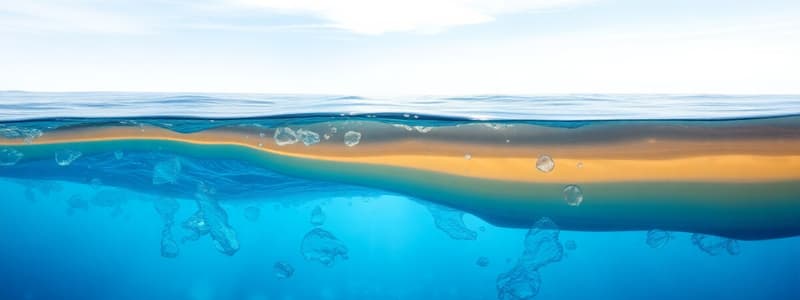Podcast
Questions and Answers
What is the lowest layer of Earth's atmosphere where life resides?
What is the lowest layer of Earth's atmosphere where life resides?
- Stratosphere
- Mesosphere
- Exosphere
- Troposphere (correct)
Which gas is NOT one of the two most abundant gases in Earth's atmosphere?
Which gas is NOT one of the two most abundant gases in Earth's atmosphere?
- Nitrogen
- Carbon Dioxide (correct)
- Oxygen
- Argon
What function does ozone serve in the stratosphere?
What function does ozone serve in the stratosphere?
- It acts as a barrier against meteors.
- It enhances greenhouse gas effects.
- It provides oxygen for breathing.
- It blocks harmful ultraviolet light. (correct)
Which layer of the atmosphere is home to most satellites?
Which layer of the atmosphere is home to most satellites?
What is the freezing point of ocean water, approximately?
What is the freezing point of ocean water, approximately?
What is the primary factor affecting the density of ocean water?
What is the primary factor affecting the density of ocean water?
Which layer of the atmosphere is described as 'the calm layer' suitable for commercial jets?
Which layer of the atmosphere is described as 'the calm layer' suitable for commercial jets?
What percentage of Earth's atmosphere is made up of nitrogen gas?
What percentage of Earth's atmosphere is made up of nitrogen gas?
Which of the following gases is considered a greenhouse gas?
Which of the following gases is considered a greenhouse gas?
What characteristic of ocean water contributes to its high heat capacity?
What characteristic of ocean water contributes to its high heat capacity?
What primarily influences surface ocean currents?
What primarily influences surface ocean currents?
What causes thermohaline circulation in ocean water?
What causes thermohaline circulation in ocean water?
What is the outermost layer of the atmosphere?
What is the outermost layer of the atmosphere?
Which layer of Earth is described as having molten rock and mineral content?
Which layer of Earth is described as having molten rock and mineral content?
What role do root plants play in the Earth's spheres?
What role do root plants play in the Earth's spheres?
What is the primary characteristic of the geosphere?
What is the primary characteristic of the geosphere?
What is the Coriolis effect responsible for in ocean currents?
What is the Coriolis effect responsible for in ocean currents?
What is the innermost layer of the Earth known as?
What is the innermost layer of the Earth known as?
Which of the following gases can be found in the atmosphere?
Which of the following gases can be found in the atmosphere?
How does density impact ocean water movement?
How does density impact ocean water movement?
Flashcards
Troposphere
Troposphere
The lowest layer of Earth's atmosphere, where life exists and weather occurs.
Stratosphere
Stratosphere
The layer above the troposphere, known for its calm conditions and where commercial jets fly.
Mesosphere
Mesosphere
The layer above the stratosphere, very cold and where most meteors burn up.
Thermosphere
Thermosphere
Signup and view all the flashcards
Exosphere
Exosphere
Signup and view all the flashcards
Salinity
Salinity
Signup and view all the flashcards
Heat Capacity
Heat Capacity
Signup and view all the flashcards
Freezing Point
Freezing Point
Signup and view all the flashcards
Density
Density
Signup and view all the flashcards
Greenhouse Gases
Greenhouse Gases
Signup and view all the flashcards
High Heat Capacity
High Heat Capacity
Signup and view all the flashcards
Currents
Currents
Signup and view all the flashcards
Ocean Currents
Ocean Currents
Signup and view all the flashcards
Surface Currents
Surface Currents
Signup and view all the flashcards
Deep Water Currents
Deep Water Currents
Signup and view all the flashcards
Coriolis Effect
Coriolis Effect
Signup and view all the flashcards
Gyre
Gyre
Signup and view all the flashcards
Thermohaline Circulation
Thermohaline Circulation
Signup and view all the flashcards
Study Notes
Earth's Atmosphere
- Earth's atmosphere is a thin layer of gases surrounding the planet.
- It has five layers: troposphere, stratosphere, mesosphere, thermosphere, and exosphere.
- The troposphere is the lowest layer, where life exists and weather occurs.
- The stratosphere is above the troposphere, and is the layer where commercial jets fly.
- The mesosphere is farther up, and where most meteors burn up.
- The thermosphere is thin, cloudless, and water-vapor-free.
- The exosphere is the outermost layer, where the atmosphere merges with space, and where most satellites orbit.
- The two most abundant gases in the atmosphere are nitrogen (78%) and oxygen (21%).
- Water vapor, argon, carbon dioxide, ozone, and methane are other trace gases.
- Ozone in the stratosphere protects Earth from harmful UV light.
- Methane and carbon dioxide are greenhouse gases, trapping heat and keeping Earth warm.
Ocean Water
- Ocean water has high salinity (salt concentration).
- It contains dissolved chemicals (like magnesium, sulfate, calcium, potassium) and dissolved gases (like nitrogen, oxygen, carbon dioxide).
- Ocean water has a high heat capacity, meaning it takes a lot of energy to change its temperature.
- The freezing point of ocean water is lower than freshwater due to salinity.
- Ocean water density depends on temperature and salinity.
- Cold, salty water is denser and sinks.
- Warm, less salty water rises.
Ocean Currents
- Ocean currents are large-scale water movements.
- Surface currents are primarily driven by wind and the Coriolis effect.
- The Coriolis effect deflects current direction. Clockwise in the Northern Hemisphere, counterclockwise in the Southern Hemisphere.
- Deep-water currents are driven by density differences.
- Temperature and salinity changes create density differences, driving the sinking and rising of water.
- This movement is called thermohaline circulation or the Global Conveyor Belt.
Coral Reefs
-
Coral reefs are marine ecosystems.
-
They are found in shallow, tropical waters.
-
Different types of coral reefs exist.
- Unknown details about types or specific categories of reefs from the provided text.
-
Coral reefs are important ecosystems.
-
Coral reef conservation is essential.
Earth's Spheres
- Earth's four spheres (atmosphere, biosphere, geosphere, hydrosphere) interact.
- Humans impact these interactions.
- Atmosphere: All the air surrounding Earth, with five layers (troposphere, stratosphere, mesosphere, thermosphere, exosphere).
- Biosphere: All living organisms (plants, animals, microbes).
- Geosphere: All solid parts of Earth (crust, mantle, core).
- Hydrosphere: All the water on Earth.
- The spheres' boundaries are not always clear-cut.
- The spheres work together to cycle materials, impact climate processes, and support life.
- Plants connect to all four spheres.
Earth's Interior
- Earth has three main layers: crust, mantle, and core.
- The crust is the outermost, thinnest layer.
- The mantle is the thickest layer, with molten rock that moves in convection currents.
- The convection currents drive tectonic plate movement, causing earthquakes and volcanoes.
- The core has an outer liquid iron layer and an inner solid iron layer (due to extreme pressure).
- Gravity caused the densest materials to move toward the center.
Studying That Suits You
Use AI to generate personalized quizzes and flashcards to suit your learning preferences.




